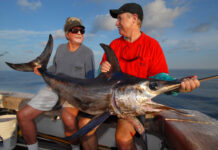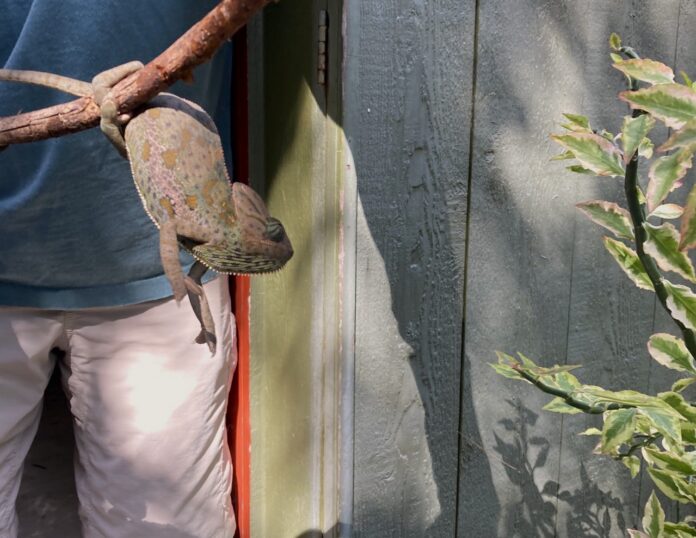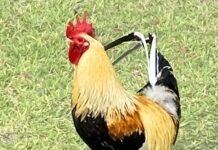As a kid who grew up hunting snakes and catching lizards, I find South Florida and the Keys to be something of a reptilian mecca. It is a mecca, however, for all the wrong reasons.
There is an impressive array of reptiles that are native to the Keys and, for a lover of these scaly things, quite a few invasive species, too. Two of the indigenous species are the American alligator and the crocodile. Did you know that South Florida and the Keys are the only places in the world where alligators and crocodiles coexist?
These are not saltwater crocodiles like the man-killers in Australia, but the American crocodile, a generally shy and reclusive animal. What makes them dangerous for those members of your family not named Spot or Fluffy is feeding them and tossing pieces of meat to draw them closer – especially while standing at the cleaning station after a day out on the water fishing.
When they associate people with food, they lose their natural fear and become considered no longer part of the ecosystem but a nuisance. Nuisance crocodiles and alligators are often euthanized because they pose a threat to humans.
Invasive reptiles are not a new thing to the Keys. In my yard alone, a whole host can be found. Of course, there are iguanas, the newly everywhere curly-tailed lizards, the occasional red-headed agama and several species of geckos. These exotic species are introduced into the environment for a myriad of reasons. For instance, the curly-tailed lizard was released into the sugar cane fields in the hopes that they would act as a form of pest control. While iguana iguana, the green iguana, has all but taken over South Florida and the Keys, it is indigenous to Central and South America.
How did they wind up in South Florida? It started with the exotic pet trade. The little green fellows escaped some of the enclosures attempting to hold them, and others were set free by thoughtless owners. In 1964, an exotic pet store owner from Miami released 300 green iguanas – on purpose.
Invasive geckos, too, were introduced to the area through the exotic pet trade. Three species of invasive geckos can be seen around my yard and house – there are others crawling around the island chain. Mediterranean geckos come out at night and are the ones my cat catches inside. Tokay geckos from Indonesia are large, heavy-bodied monsters with a strong bite, and are quite beautiful with orange and purple hues. It is their song that echoes through the neighborhood at night.

The other invasive is the star from the Geico insurance commercials that, in real life, is a Madagascar day gecko. There is one native gecko in the yard. It is the reef gecko and is considered to be North America’s smallest lizard. I used to see them every time I moved a trash can. Since they developed the empty lot next door into a house with a pea rock yard, I have not seen one wriggle off when I take the trash cans out to the side of the road. I keep looking, though, and hoping they return.
There are also the anoles, besides the curly tails the most common lizards found scurrying around the yard. I know that at least four different kinds of anoles are living in the neighborhood. The brown anole, the bark anole and the largest of the anoles, the Cuban knight anole, perhaps the grumpiest and the one with the worst temperament of the local anoles, are all invasive.
The only native anole is the Carolina anole or green anole. I grew up calling them chameleons because they can change their color so dramatically from brown to green. Now, it looks like there might be a new invasive reptile climbing through the neighborhood trees. Unlike the green anole I grew up calling a chameleon, and that is sometimes referred to as the American chameleon, the real thing appears to have arrived – maybe.
Breeding populations of veiled chameleons have become established on the mainland. They were first observed in 2000-2002. A striking species, they are native to the Arabian peninsula and the mountainous regions of Yemen – bordered by Saudi Arabia to the north and the Red Sea to the west. Brightly colored and interestingly adorned with a large “horn” or crest atop their head, they are popular in the herpetology trade and retail from $129 to $349 each on at least one site.
The veiled chameleon represents one of the worst examples of the invasive species problem proliferating on and around the southern tip of the Florida peninsula and, maybe, now in the Keys. Reptile breeders and sellers take breeding pairs of a species and let them loose in the environment. Many, like the veiled chameleon, thrive and begin to expand their territory. The breeders are then able to go catch and sell them.
Veiled chameleons can now be found from Lee County to Florida City and north into Miami-Dade County. In recent months, poachers were caught in the Big Cypress National Preserve with a reported 150 chameleons. They are out there. Apparently, they are in the Keys, too.
On a Thursday morning in late January, a veiled chameleon was found in a Plantation Key yard. On Friday morning, a second one was discovered. Before discovering these two, a third had been reported on Plantation Key. Often, these lizards enter the Keys via the farms and nurseries in Homestead as accidental hitchhikers – which is probably how these three arrived.
Are there others? Maybe. If you find an unusual creature in your yard or on some Florida Keys adventure, report it by calling the Exotic Species Hotline at 888-483-4681.




















